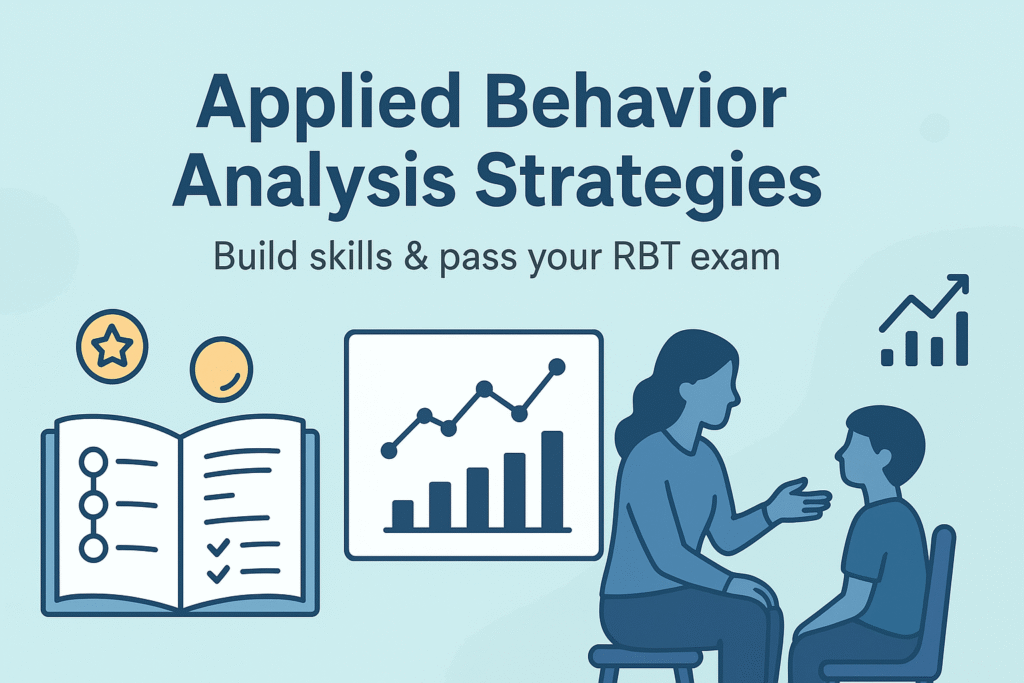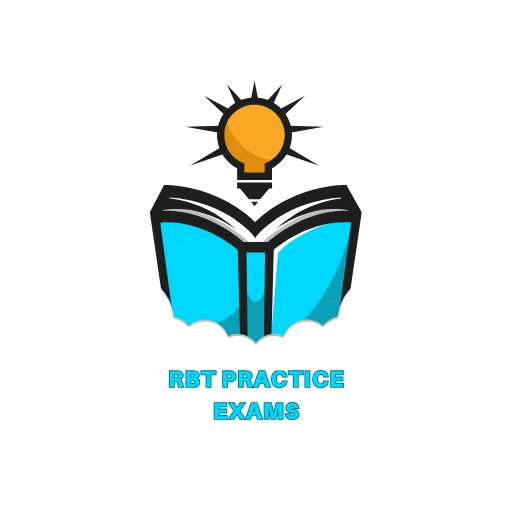Applied behavior analysis strategies are practical tools that help shape behavior, teach new skills, and improve everyday life for children and adults. These methods are widely used in therapy, education, and clinical practice, especially for individuals with autism and developmental differences. If you are preparing for the RBT certification, understanding these strategies is not only helpful for practice but also essential for passing your rbt practice exam.
In this guide, we’ll break down the most effective applied behavior analysis strategies, explain how they work, and connect them to what you’ll see on the RBT exam.
Table of Contents

What Are Applied Behavior Analysis Strategies?
Applied behavior analysis (ABA) is the science of learning and behavior. According to the BACB , ABA uses systematic approaches to bring meaningful change in socially significant behaviors. ABA strategies are the specific techniques practitioners use to teach, reduce challenging behaviors, and promote independence.
Some strategies focus on teaching new skills, while others address behavior reduction. Together, they form the foundation of ABA therapy, making them essential knowledge for both practice and exam preparation.
Why ABA Strategies Matter for RBTs?
As an RBT, your role is to implement behavior plans created by a supervising BCBA. This means you’ll apply strategies directly with clients, collect data, and support skill-building. On your rbt practice test , you’ll see questions that test your knowledge of reinforcement, prompting, task analysis, and more.
Learning these strategies helps you:
Build confidence in working with clients.
Recognize which strategy matches which situation.
Answer scenario-based exam questions correctly.
The Core Applied Behavior Analysis Strategies
Let’s look at the most widely used ABA strategies, their purpose, and how they connect to exam prep.
- Reinforcement
Reinforcement strengthens behavior by following it with something rewarding.
Positive reinforcement: Adding something enjoyable (praise, tokens, snacks).
Negative reinforcement: Removing something unpleasant (ending a demand when a task is started).
Example: A child completes homework, and the parent provides extra playtime.
On the exam: Expect questions asking you to identify which type of reinforcement is being used in a scenario.
- Prompting and Prompt Fading
Prompts help learners complete tasks, while fading ensures independence.
Types of prompts: verbal, gestural, physical, visual, modeling.
Fading: Gradually reducing prompts until the learner responds on their own.
Example: Teaching shoe-tying by first guiding hand-over-hand, then shifting to verbal prompts.
For RBT prep: Know the order of least-to-most and most-to-least prompting systems.
- Discrete Trial Training (DTT)
DTT breaks skills into small steps with clear instructions, responses, and feedback.
Structure: Antecedent Response Consequence Data.
Goal: Build mastery through repetition.
Example: Teaching colors by holding up a card and asking, “What color is this?”
Exam tip: DTT is often paired with reinforcement questions.
- Task Analysis and Chaining
Task analysis breaks complex skills into smaller parts. Chaining teaches each part step by step.
Forward chaining: Start with the first step, then add more.
Backward chaining: Teach the last step first, then move backward.
Total task: Teach all steps at once.
Example: Teaching handwashing as a series of steps: turn on water, apply soap, scrub, rinse, dry.
RBT exam alert: Be able to identify when to use forward vs backward chaining.
- Shaping
Shaping reinforces small steps toward a final goal behavior. Example: Rewarding approximations of saying “water” until the child can say it clearly.
On the test: Look for scenarios where gradual progress is encouraged.
- Generalization
Generalization means a skill is used in new settings, with different people, or in different situations. Example: A child learns to request a toy in therapy and later uses the same request at home.
Exam prep: Expect questions about promoting generalization across environments.
- Functional Behavior Assessment (FBA)
FBA identifies why a behavior occurs and guides the choice of strategies. Functions include:
Escape
Attention
Tangible
Automatic
Example: A student throws books to escape difficult tasks.
While RBTs don’t conduct full FBAs, you’ll need to collect data and recognize patterns.
- Antecedent Interventions
These strategies adjust what happens before a behavior to reduce the chance of it occurring. Example: Giving choices before starting a task to prevent refusal behavior.
Exam note: Be ready to spot how antecedent strategies differ from reinforcement.
How ABA Strategies Are Used in Real Life
ABA strategies are not just for therapy rooms. They are practical and flexible:
At school: Teachers use reinforcement and task analysis to build learning routines.
At home: Parents apply prompting and shaping to teach daily living skills.
In the community: Generalization ensures skills transfer to new environments.
For RBTs, mastering these strategies ensures both effective practice and exam success.
Common Questions About ABA Strategies What are applied behavior analysis strategies?
They are systematic methods used in ABA therapy to teach skills, reduce problem behaviors, and promote independence.
What are the 5 main ABA strategies?
Reinforcement, prompting, discrete trial training, task analysis, and shaping are often highlighted as the core five.
How do ABA strategies help in the classroom?
They support structured teaching, increase engagement, and help students generalize learning across subjects.
Which ABA strategies are most important for the RBT exam?
Reinforcement, prompting, task analysis, and DTT appear frequently in exam scenarios. Practice with an rbt mock test to prepare.
Final Thoughts
Mastering ABA Strategies for Exam Success
Applied behavior analysis strategies are the foundation of effective therapy and the backbone of your RBT exam preparation. By understanding reinforcement, prompting, shaping, chaining, and other methods, you’ll be well-prepared to answer exam questions and apply your skills in real practice.
If you’re ready to test your knowledge, start with a rbt practice exam today. It’s the best way to strengthen your confidence and get exam-ready.
